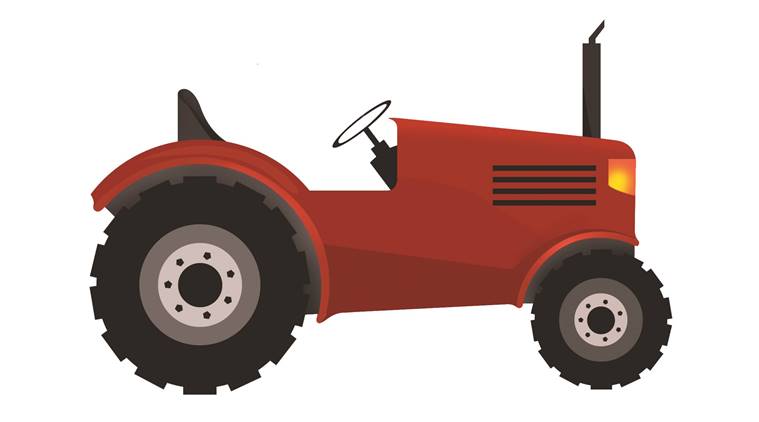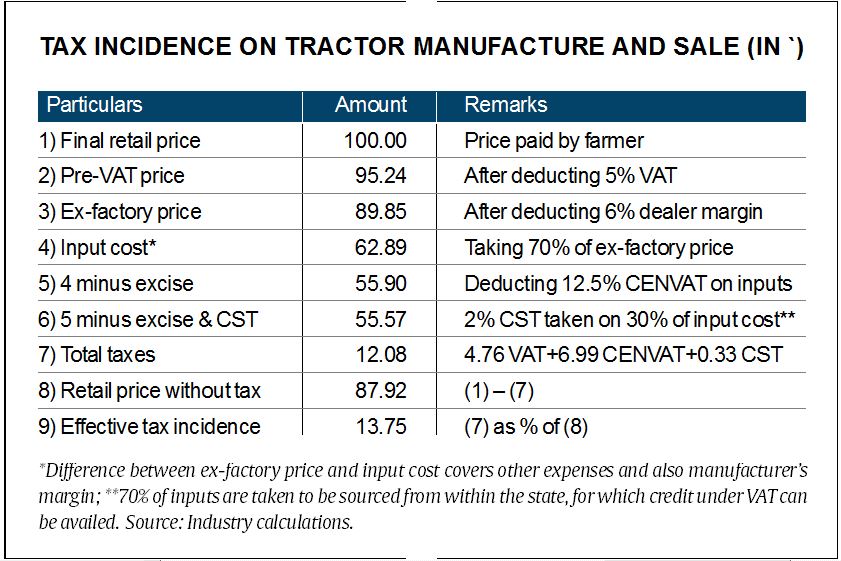One does not know of too many industries today desperately seeking to be taxed. Tractor makers are among those, probably a handful, lobbying hard to get the excise duty exemption now on their product removed — more so, with the scheduled rollout of a nationwide Goods and Services Tax (GST) from July 1.
The reason for their apparently strange demand is simple: Not being chargeable to excise on output means it is not possible for manufacturers to claim any credit for duties and taxes paid on inputs. The tractor industry is at present forking out the Cenvat (Central VAT or value added tax) rate of 12.5 per cent on most components — engine, gearbox, drive shaft, differential unit, wheels/tyres, fuel injection pump, electricals, seats, castings, forgings, sheet metal fabrication, etc. These cannot be set off, however, given that the final product — tractor — does not attract any excise.


“GST should technically allow for tax on output to be set off against duties/taxes paid on inputs. But we dread a situation where the tax incidence on our inputs may further go up — because of the standard revenue-neutral GST rate (for the Centre and states combined) being fixed at, say, 18 per cent — and the exemption for tractors would still remain,” an industry source told The Indian Express.
Story continues below this ad
Tractors were fully exempted from excise duty — earlier 16 per cent — in the 2004-05 Union Budget of the first United Progressive Alliance (UPA) government. “We never sought it then. And now, we are all the more desperate that it goes,” said the source. But restoring duty, he admitted, is politically easier said than done, especially in the current environment where the Opposition is looking to somehow corner a ruling party that’s truly on a roll. Removal of exemption for tractors and other farm machinery — when there’s simultaneous talk of also taxing agricultural incomes — could provide just that godsend opportunity.

The industry’s contention, however, is that farmers are, as it is, indirectly paying taxes and duties on the components, parts, capital equipment and services used in tractor-making. Since the manufacturers are in no position to claim input credit, they are simply passing these on to farmers by hiking ex-factory prices. Farmers are, in other words, effectively paying more, even though there is no “visible” excise duty on tractors.
The total tax incidence on domestically produced tractors works out to around 13.75 per cent of the pre-tax price, as per industry calculations (see table). That includes the 5-5.5 per cent VAT being levied on tractor sales by most states, a two per cent Central Sales Tax or CST on inter-state purchase (roughly 70 per cent of inputs are procured locally and the balance from outside the state of manufacture/final assembly), and the 12.5 per cent Cenvat on components and parts. If tax on various service inputs, which are also non-creditable, gets added, the overall incidence would be 13.85 per cent or so. “Thus, if a farmer is paying Rs 6 lakh for a standard 40-horsepower tractor, over Rs 73,000 constitutes duties and taxes,” claimed the source.
The industry has “given in writing” to the government that the final price to the farmer will not go up even if a 12 per cent GST rate is levied on tractors. “If the cumulative input duties and taxes, which we now incur and pass on, can be set off, why should we raise end-user prices at all? The people in the government appreciate our logic, but we’re not sure whether that will lead them to bring back duty on tractors. Politically, it’s a decision not easy to sell,” the source pointed out.
Story continues below this ad
All this comes even as the GST Council, comprising the finance ministers of all states and the Centre, is slated to meet in Srinagar on May 18-19 to decide on the rates to be applicable on different commodities. In the case of tractors, one option might be to fit the GST rate at the 5 per cent slab, which is also equal to the existing VAT levied by states. But this is obviously not acceptable to the industry, as it will enable only partial setoff of duties on inputs, which, in turn, may even attract a higher GST slab of 18 per cent.
A second option — politically more palatable — is to have a “zero-rated” duty on tractors. Manufacturers of “zero-rated” goods are entitled to claim full refund of duties and taxes paid on inputs. This is as opposed to “exempted” goods, where input tax credit cannot be availed even if the end-product is not taxed. For the industry, however, “zero-rating” is the least desired option.
“Claiming refund from government would mean waiting for a minimum of six months, besides endless paper work towards submitting claims. In the meantime, there will be huge liquidity and working capital pressures, as zero-rating also mandates us to immediately reduce prices in line with the GST’s anti-profiteering provisions. The industry wants neither zero-rating nor exemption. A 12 per cent GST on tractors, which will allow set offs against input taxes through the normal process, is all what we desire,” added the source.
Tractor manufacturers saw their domestic sales boom during the UPA regime from 2004-05 to 2013-14, trebling from under two lakh to 6.3 lakh-plus units. Sales collapsed in the first two years of the current government to well below 5 lakh units, due to a combination of low crop prices and consecutive droughts. In 2016-17, there was a recovery of sorts, with sales crossing 5.8 lakh units (see chart).
Story continues below this ad
“Last year, sales were flat in the South, where it didn’t rain much, and also partly impacted by demonetisation. But North, West and Central India registered a rebound on the back of a good monsoon and bumper crop production. This year should hopefully be better. If the Met Department’s prediction of a normal monsoon comes right, we could look forward to record sales,” said TR Kesavan, president and chief operating officer of the Chennai-based Tractors and Farm Equipment Limited, the country’s second largest tractor maker after Mahindra & Mahindra.
A fix on GST will, of course, only help.

 The tractor industry is at present forking out the Cenvat rate of 12.5 per cent on most components (Graphic: Sarfaraz)
The tractor industry is at present forking out the Cenvat rate of 12.5 per cent on most components (Graphic: Sarfaraz)
































